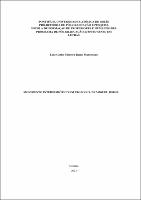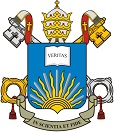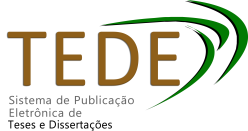| Compartilhamento |


|
Use este identificador para citar ou linkar para este item:
http://tede2.pucgoias.edu.br:8080/handle/tede/5040| Tipo do documento: | Dissertação |
| Título: | Movimento intersemiótico em Profugus, de Miguel Jorge |
| Título(s) alternativo(s): | Intersemiotic movement in Profugus, by Miguel Jorge |
| Autor: | Mantovano, Luiz Carlos Moreira Ramo |
| Primeiro orientador: | Oliveira, Custódia Annunziata Spencieri de |
| Primeiro membro da banca: | Pinto, Divino José |
| Segundo membro da banca: | Bretas, Maria Luiza Batista |
| Resumo: | Esta pesquisa tem por objetivo a análise do movimento intersemiótico contido no livro de poemas Profugus, do escritor Miguel Jorge, publicado em 1990 e que lhe rendeu o prêmio Bolsa de Publicações Hugo de Carvalho Ramos, de Goiânia, Goiás. Desde o título instigante, "Profugus", emana do livro um processo de construção inovador, que vai desde a sua organização até sua apresentação final, extremamente provocativo pelo forte movimento que aflora dos seus esquemas e manuseio da linguagem. A temática dos poemas se baseia no ser do homem, suas contradições, seu movimento fugidio, nômade. E a construção dessa temática é feita por um movimento semiótico e intersemiótico por meio do qual o leitor é chamado a se colocar frente a si mesmo como ser humano e frente a alguns questionamentos sobre o próprio livro: a organização do livro seria apenas um movimento desviante? O que seria prófugo: o homem, o livro, ou um é o veículo para se atingir o outro? O autor adverte: "Há que se entender o homem" e, para entender esse Homem, buscou-se compreender a construção inusitada da linguagem sob a sustentação dos semioticistas: Peirce (2000), Greimas (1975), Hjelmslev (2013), Barthes (1989), Eco (1976), Austin (1962); e dos teóricos que tratam do gênero lírico: Todorov (1978), Hugo Friedrich (1978), Hamburguer (1986), Borges (2019). Por meio da pesquisa bibliográfica, foi possível observar como o movimento criado pela organização da linguagem performatiza, pelos sujeitos de enunciação do discurso presentes na lírica jorgiana, a vivência nômade e fugidia do homem. Miguel Jorge transforma a palavra na própria arte e seu código modificado causa movimentos instigantes por meio das sonoridades bem organizadas, da organização visual da palavra, do trânsito intersemiótico entre o código visual e o código linguístico. O livro mostra-se um rico campo de análise, pois pode ser observado desde a ótica filosófica, a psicológica ou a social. No entanto, pelo enfoque do movimento semiótico, a pesquisa pode mostrar os terrenos movediços da linguagem que proporcionarão aos leitores uma base para uma possível continuidade de análise através de outras abordagens |
| Abstract: | This research aims to analyze the intersemiotic movement contained in the book of poems Profugus, by the writer Miguel Jorge, published in 1990 and which earned him the Bolsa de Publicações Hugo de Carvalho Ramos award, from Goiânia, Goiás. From the thoughtprovoking title, "Profugus", an innovative construction process emanates from the book, ranging from its organization to its final presentation, extremely provocative due to the strong movement that emerges from its schemes and related to language. The theme of the poems is based on the being of man, his contradictions, his fugitive, nomadic movement. And the construction of this theme is done through a semiotic and intersemiotic movement through which the reader is called to face himself as a human being and face some questions about the book itself: the organization of the book would be just a deviant movement ? What would be profugal: the man, the book, or is one the vehicle to reach the other? The author announces: "We have to understand man" and, to understand this Man, we sought to understand the unusual construction of language under the support of semioticians: Peirce (2000), Greimas (1975), Hjelmslev (2013), Barthes (1989), Eco (1976), Austin (1962); and theorists who deal with the lyrical genre: Todorov (1978), Hugo Friedrich (1978), Hamburguer (1986), Borges (2019). Through bibliographical research, it was possible to observe how the movement created by the organization of the performed language, by the subjects of enunciation of the discourse present in the Georgian lyric, the nomadic and fugitive experience of man. Miguel Jorge transforms the word into art itself and his modified code causes instigating movements through the wellorganized sounds, the visual organization of the word, the intersemiotic transit between the visual code and the linguistic code. The book proves to be a rich field of analysis, as it can be observed from a philosophical, psychological or social perspective. However, through the semiotic movement approach, research can show the moved terrains of language that provide readers with a basis for a possible continuity of analysis through other approaches |
| Palavras-chave: | Semiótica Movimento Miguel Jorge |
| Área(s) do CNPq: | Linguística, Letras e Artes Letras |
| Idioma: | por |
| País: | Brasil |
| Instituição: | Pontifícia Universidade Católica de Goiás |
| Sigla da instituição: | PUC Goiás |
| Departamento: | Escola de Formação de Professores e Humanidades |
| Programa: | Programa de Pós-Graduação STRICTO SENSU em Letras |
| Citação: | MANTOVANO, Luiz Carlos Moreira Ramo. Movimento intersemiótico em Profugus, de Miguel Jorge. 2023. 77 f. Dissertação (Mestrado em Letras) -- Escola de Formação de Professores e Humanidades, Pontifícia Universidade Católica de Goiás, Goiânia, 2023. |
| Tipo de acesso: | Acesso Aberto |
| URI: | http://tede2.pucgoias.edu.br:8080/handle/tede/5040 |
| Data de defesa: | 30-Out-2023 |
| Aparece nas coleções: | Mestrado em Letras |
Arquivos associados a este item:
| Arquivo | Descrição | Tamanho | Formato | |
|---|---|---|---|---|
| Luiz Carlos Moreira Ramo Mantovano.pdf.crdownload | Texto Completo | 1,45 MB | Adobe PDF |  Baixar/Abrir Pré-Visualizar |
Os itens no repositório estão protegidos por copyright, com todos os direitos reservados, salvo quando é indicado o contrário.




